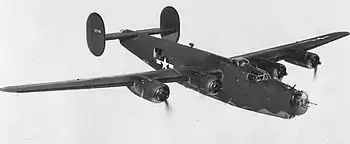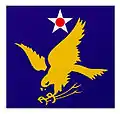825th Bombardment Squadron
The 825th Bombardment Squadron is an inactive United States Air Force unit. It was assigned to the 484th Bombardment Group and was last stationed at Casablanca Airport, French Morocco, where it was inactivated on 25 July 1945. The squadron was activated during World War II as a Consolidated B-24 Liberator unit. It served in combat in the Mediterranean Theater of Operations, earning two Distinguished Unit Citations for operations over Germany and Austria. Following V-E Day it operated with Air Transport Command in returning American troops to the United States until it was inactivated in theater in the summer of 1945.
| 825th Bombardment Squadron | |
|---|---|
 B-24 Liberator as flown by the squadron | |
| Active | 1943-1945 |
| Country | |
| Branch | |
| Role | heavy bomber |
| Engagements | Mediterranean Theater of Operations |
| Decorations | Distinguished Unit Citation |
| Insignia | |
| 825th Bombardment Sq emblem[1] |  |
History
The 825th Bombardment Squadron was first activated at Harvard Army Air Field, Nebraska on 20 September 1943 as one of the four squadrons of the 484th Bombardment Group. The squadron trained with Consolidated B-24 Liberators until March 1944, when it moved to the Mediterranean Theater of Operations. Shortly before deploying, the squadron was redesignated as a Pathfinder unit, although it never performed pathfinder missions.[2][3][note 1]
In April 1944, the squadron began flying combat missions from Torretto Airfield, Italy in the strategic bombing campaign against Germany. Until the end of the war, it acted primarily as a strategic bombing organization, attacking oil refineries and storage facilities, industrial facilities and lines of communication in Italy, France, Germany, Austria, Czechoslovakia, Hungary and the Balkans. On 13 June 1944, the unit's target was marshalling yards near Munich, Germany. However, the Germans deployed a smoke screen that effectively hid the target, making the attack unfeasible. Despite losses from flak and interceptor aircraft, the squadron proceeded to its secondary target at Innsbruck, Austria. Its persistence in the face of opposition earned the unit a Distinguished Unit Citation (DUC).[3]
Two months later, on 21 August 1944, the squadron received a second DUC for an attack on underground oil storage facilities near Vienna, Austria. Without fighter escort, the squadron fought its way through intense opposition to strike the target.[3]
The squadron was sometimes diverted from strategic targets. It bombed bridges, viaducts, marshalling yards, and supply dumps to assist troops advancing on Rome between April and July 1944. In September 1944, the unit transported petroleum products to troops participating in Operation Dragoon, the invasion of southern France. At the end of the war it supported Operation Grapeshot, the final advances in northern Italy.[3]
Following V-E Day, The unit was assigned to Air Transport Command, It used its B-24s as transport aircraft, flying personnel from locations in France and Italy to Casablanca, French Morocco as part of the Green Project. It also engaged in transport operations from North Africa to the Azores or Dakar in French West Africa until it was inactivated on 25 July 1945.[2][3]
Lineage
- Constituted as the 825th Bombardment Squadron (Heavy) on 14 September 1943
- Activated on 20 September 1943
- Redesignated 825th Bombardment Squadron (Pathfinder) on 14 February 1944
- Redesignated 825th Bombardment Squadron, Heavy on 11 November 1944
- Inactivated on 25 July 1945[2]
Assignments
- 484th Bombardment Group, 20 September 1943 – 25 July 1945[2]
Stations
- Harvard Army Air Field, Nebraska, 20 September 1943 – 2 March 1944
- Torretto Airfield, Italy, April 1944
- Casablanca-Anfa Airport, French Morocco, c. 25 May – 25 July 1945[2]
Aircraft
- Consolidated B-24 Liberator, 1943–1945[2]
Awards and campaigns
| Award streamer | Award | Dates | Notes |
|---|---|---|---|
| Distinguished Unit Citation | 13 June 1944 | Munich, Germany and Innsbruck, Austria[2] | |
| Distinguished Unit Citation | 22 August 1944 | Vienna, Austria[2] |
| Campaign Streamer | Campaign | Dates | Notes |
|---|---|---|---|
| Air Offensive, Europe | April 1944–5 June 1944 | [2] | |
| Central Europe | April 1944–21 May 1945 | [2] | |
| Air Combat, EAME Theater | April 1944–11 May 1945 | [2] | |
| Rome-Arno | April 1944–9 September 1944 | [2] | |
| Normandy | 6 June 1944 – 24 July 1944 | [2] | |
| Northern France | 25 July 1944 – 14 September 1944 | [2] | |
| Southern France | 15 August 1944 – 14 September 1944 | [2] | |
| North Apennines | 10 September 1944 – 4 April 1945 | [2] | |
| Rhineland | 15 September 1944 – 21 March 1945 | [2] | |
| Po Valley | 3 April 1945 – 8 May 1945 | [2] |
References
Notes
- Explanatory notes
- Pathfinder units were equipped with early radar bombing equipment and were intended to be deployed to other bombardment groups to act as lead aircraft on bombing missions where cloud cover obscured the target. The Army Air Forces formed one group in England, but eventually elected to train selected crews in each of its groups for this mission. Freeman, pp. 117-118
- Citations
- Watkins, pp. 118-119
- Maurer, Combat Squadrons, p. 771
- Maurer, Combat Units, pp. 355-356
Bibliography
![]() This article incorporates public domain material from the Air Force Historical Research Agency website http://www.afhra.af.mil/.
This article incorporates public domain material from the Air Force Historical Research Agency website http://www.afhra.af.mil/.
- Freeman, Roger A. (1970). The Mighty Eighth: Units, Men and Machines (A History of the US 8th Army Air Force). London, England, UK: Macdonald and Company. ISBN 978-0-87938-638-2.
- Maurer, Maurer, ed. (1983) [1961]. Air Force Combat Units of World War II (PDF) (reprint ed.). Washington, DC: Office of Air Force History. ISBN 0-912799-02-1. LCCN 61060979. Retrieved 17 December 2016.
- Maurer, Maurer, ed. (1982) [1969]. Combat Squadrons of the Air Force, World War II (PDF) (reprint ed.). Washington, DC: Office of Air Force History. ISBN 0-405-12194-6. LCCN 70605402. OCLC 72556. Retrieved 17 December 2016.
- Watkins, Robert A. (2009). Insignia and Aircraft Markings of the U.S. Army Air Force In World War II. Volume IV, European-African-Middle Eastern Theater of Operations. Atglen,PA: Shiffer Publishing, Ltd. ISBN 978-0-7643-3401-6.
External links
- "484th Bombardment Group (H)". 484th Bombardment Group Association. Retrieved 20 October 2018.
.svg.png.webp)
